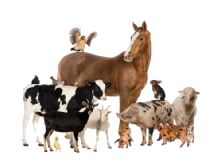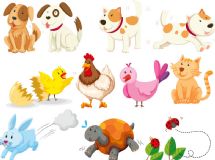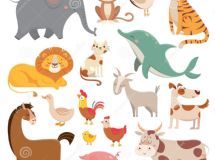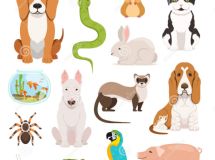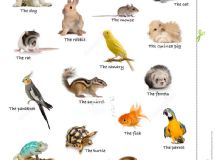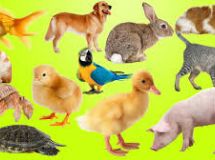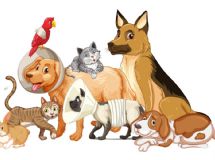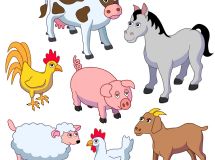Choosing to switch your dog to a raw food diet can be a bit intimidating.
There are so many things to consider and you want to do what's best for your dog as you are ultimately responsible for his health.
Feeding a raw diet means you don't have the AAFCO regulating your dog's diet and you won't have the convenience of prefabricated nutrients.
Your vet may not be in favor of recommending a diet that he doesn't sell and any information about raw diets seems to point out it has its pros and cons.
Another question you may find yourself considering is how much food does your dog need when on a raw diet.
The first change you'll come across when feeding a raw diet is that you'll be weighing portions now and not measuring them with a cup or spoon, so it's time to invest in a good kitchen scale.
A general rule of thumb is to feed normal, healthy adult dogs approximately 2-4 percent of their body weight.
You should also take into consideration your dog's activity levels and adjust accordingly.
Depending on what you feed your dog, you will have to take into consideration fat to lean ratios in the food you're giving your dog.
This means if you're feeding a fatty cut of meat, you should use less than you would with a lean cut as fat contains many calories.
Pregnant or lactating females and puppies need higher calories and will need a higher percentage of food to total body weight.
Never increase or change your dog's diet suddenly, you should introduce any changes in food or quantities gradually to avoid digestive upsets.
When feeding a raw diet, it's recommended that you feed different kinds of meats because different meats contain different nutritional values.
If your dog has food allergies you should only feed items that you know are tolerated by your dog.
Red meats are a good source of B vitamins and iron whereas meat from cold water fish contains essential fatty acids.
You should be careful when feeding your dog fish to make sure it comes from a safe source and never overfeed your dog fish as it can cause a mercury overload on your dog's system.
Organ meats are good sources of vitamins and nutrients but keep in mind that organs usually contain toxins and hormones that are added to meat.
Livestock given antibiotics and hormones will store these harmful substances in organs such as the kidney, liver and spleen.
Hearts are nutritious and relatively safe to add to your dog's raw diet.
Green tripe a hard to find food is much loved by most dogs.
It smells awful but is very nutritious as it contains digestive enzymes and partially digested grasses that your dog will benefit from.
If you can, try to feed your dog exotic meats such as elk, venison goat, rabbit and duck.
Pork is fine as long as you don't overdo it as it contains a lot of fat and can cause some dogs pancreatitis.
If your dog likes them, you can add fruits and vegetables to your dog's diet but avoid foods that are toxic to dogs such as onions and grapes.
Dogs aren't completely carnivorous and can eat a variety of foods unlike cats who are solely carnivorous.
You can also feed your dog yogurt if he likes it but try to use brands with probiotics added.
Dogs also enjoy buttermilk which is another good source of probiotics.
You can also feed your dog table scraps and leftovers but be careful not to overdo it.
There are so many things to consider and you want to do what's best for your dog as you are ultimately responsible for his health.
Feeding a raw diet means you don't have the AAFCO regulating your dog's diet and you won't have the convenience of prefabricated nutrients.
Your vet may not be in favor of recommending a diet that he doesn't sell and any information about raw diets seems to point out it has its pros and cons.
Another question you may find yourself considering is how much food does your dog need when on a raw diet.
The first change you'll come across when feeding a raw diet is that you'll be weighing portions now and not measuring them with a cup or spoon, so it's time to invest in a good kitchen scale.
A general rule of thumb is to feed normal, healthy adult dogs approximately 2-4 percent of their body weight.
You should also take into consideration your dog's activity levels and adjust accordingly.
Depending on what you feed your dog, you will have to take into consideration fat to lean ratios in the food you're giving your dog.
This means if you're feeding a fatty cut of meat, you should use less than you would with a lean cut as fat contains many calories.
Pregnant or lactating females and puppies need higher calories and will need a higher percentage of food to total body weight.
Never increase or change your dog's diet suddenly, you should introduce any changes in food or quantities gradually to avoid digestive upsets.
When feeding a raw diet, it's recommended that you feed different kinds of meats because different meats contain different nutritional values.
If your dog has food allergies you should only feed items that you know are tolerated by your dog.
Red meats are a good source of B vitamins and iron whereas meat from cold water fish contains essential fatty acids.
You should be careful when feeding your dog fish to make sure it comes from a safe source and never overfeed your dog fish as it can cause a mercury overload on your dog's system.
Organ meats are good sources of vitamins and nutrients but keep in mind that organs usually contain toxins and hormones that are added to meat.
Livestock given antibiotics and hormones will store these harmful substances in organs such as the kidney, liver and spleen.
Hearts are nutritious and relatively safe to add to your dog's raw diet.
Green tripe a hard to find food is much loved by most dogs.
It smells awful but is very nutritious as it contains digestive enzymes and partially digested grasses that your dog will benefit from.
If you can, try to feed your dog exotic meats such as elk, venison goat, rabbit and duck.
Pork is fine as long as you don't overdo it as it contains a lot of fat and can cause some dogs pancreatitis.
If your dog likes them, you can add fruits and vegetables to your dog's diet but avoid foods that are toxic to dogs such as onions and grapes.
Dogs aren't completely carnivorous and can eat a variety of foods unlike cats who are solely carnivorous.
You can also feed your dog yogurt if he likes it but try to use brands with probiotics added.
Dogs also enjoy buttermilk which is another good source of probiotics.
You can also feed your dog table scraps and leftovers but be careful not to overdo it.
SHARE

